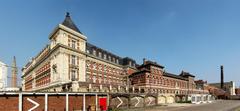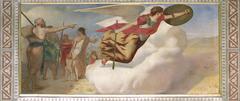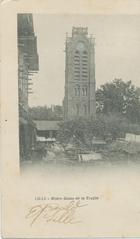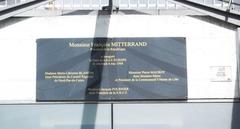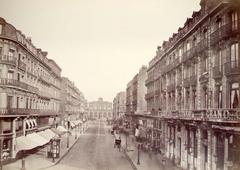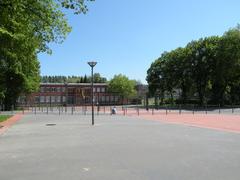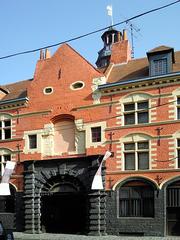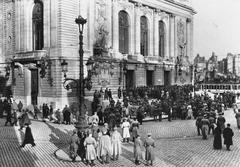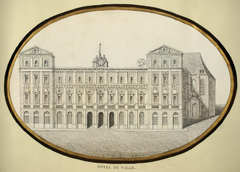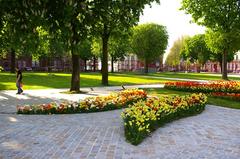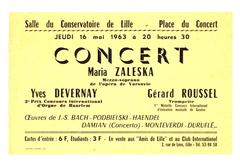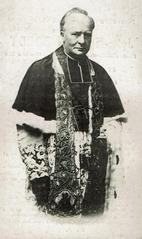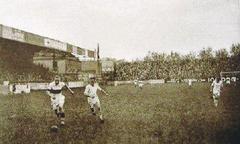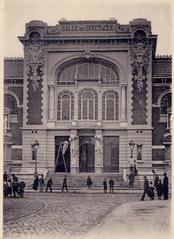
Gare Lille-Flandres: Visiting Hours, Tickets, History, and Comprehensive Travel Guide
Date: 04/07/2025
Introduction
Gare Lille-Flandres is far more than a bustling transit point—it’s an emblem of Lille’s historical and cultural evolution. Its neoclassical façade, once part of Paris’s Gare du Nord, and its vibrant location at the heart of the city make it not only a gateway for travelers but also a monument in its own right. Whether you’re arriving to explore Lille’s rich heritage, seek practical travel tips, or admire the station’s architectural features, this guide offers all the essential information on visiting hours, ticketing, nearby attractions, and more.
Table of Contents
- Historical Overview & Architectural Significance
- Modernization and Current Role
- Visiting Gare Lille-Flandres: Key Information
- Transport Connections
- Top Nearby Attractions
- Cultural Insights & Events
- Frequently Asked Questions (FAQ)
- Conclusion & Recommendations
- References
Historical Overview & Architectural Significance
Origins and Early Development
The railway’s arrival in Lille began in 1842, with the first station opening in 1846 as Lille’s fortifications were pierced to allow direct rail access. This event marked Lille’s transformation into a major industrial and commercial hub, linking it with Paris and other cities (C’est en France, Plume de Busette).
From Paris to Lille: The Transplanted Façade
The current neoclassical façade was originally built for Paris’s Gare du Nord but proved too small for the capital’s needs. In 1867, it was dismantled stone by stone, transported, and reassembled in Lille, symbolizing the city’s growing prominence. Architect Léonce Reynaud’s design, featuring grand columns and a stately pediment, was enhanced with an extra floor and a clock to emphasize Lille’s regional status (C’est en France).
Architectural and Urban Context
Sidney Dunnett’s late-19th-century redesign introduced an airy iron-and-glass train shed, filling the platforms with natural light—a hallmark of modern railway architecture. The station’s position on rue Faidherbe, facing the Opéra de Lille, creates a striking urban ensemble and situates the station within Lille’s historic and cultural fabric (Plume de Busette).
Historical Events and Wartime Role
During World War II, the station played a key role in the Resistance. In April 1944, telephone operators at the station helped prevent a massacre by transmitting critical information, underscoring the station’s importance beyond transport (C’est en France).
Modernization and Current Role
Major renovations in recent decades have equipped Gare Lille-Flandres to handle over 20 million annual passengers, making it France’s busiest TER (regional) station and the city’s second busiest after Lille-Europe (Plume de Busette). The upgrades balance preservation of historic features with contemporary comfort and efficiency.
Visiting Gare Lille-Flandres: Key Information
Opening Hours
- Station Hours: Daily, from approximately 4:30 AM to midnight.
- Ticket Offices: Typically open from 6:00 AM to 9:00 PM.
- Note: Hours may vary on holidays; consult the official SNCF website for updates.
Ticketing
- Purchase Options: Buy tickets for TER, Intercity, and TGV trains at station counters, self-service machines, or online (oui.sncf).
- Regional Fares: TER tickets start at around €10.
- City Pass: The 48-hour Lille City Pass (€35) covers public transport and entry to 27 attractions (Lonely Planet).
- Tip: Book in advance during busy periods for best availability.
Accessibility
- Facilities: Ramps, elevators, tactile paving, accessible restrooms.
- Assistance: Request ‘Accès Plus’ support at least 48 hours prior to travel (+33 (0)8 90 64 06 50).
- Plan Ahead: Arrive 30 minutes early if assistance is needed (BonjourLaFrance).
Station Layout & Facilities
- Platforms: 17 tracks (numbered 0–16) and 9 platforms, all at street level for easy navigation.
- Amenities: Shops, cafés, bakeries, restrooms (fee applies), free Wi-Fi, business center.
- Luggage: No official left-luggage service—use nearby storage apps or services (BonjourLaFrance).
- Signage: Bilingual (French/English), clear wayfinding.
Safety & Practical Tips
- Security: CCTV monitored, visible security presence.
- Restrooms: Require coins.
- Lost Property: Fees may apply for retrieval.
- Food: Try local specialties at on-site eateries or nearby estaminets.
- ATMs & Currency Exchange: Available in the city center.
- Parking: Secure options nearby—reserve ahead.
- Airport Access: Lille–Lesquin Airport is 11 km away; reachable by shuttle or taxi (Lille Metropole).
Transport Connections
Metro & Tram
- Metro Lines 1 & 2: Serve the station with frequent, automated trains (World of Metro).
- Tram Lines R & T: Connect Lille with Roubaix and Tourcoing (Expat.com).
- Public Transport Passes: From €9.80 for two days.
Bus & Taxi
- Over 140 bus routes stop outside.
- Taxi ranks available at both exits; rideshare apps are popular.
Bike & Scooter Hire
- V’Lille bike stations and e-scooters are widely accessible (Lille Metropole).
Lille-Europe Transfers
- Distance: 400 meters (7-minute walk) or one stop on Metro Line 2 (Show Me The Journey).
- Way: Exit Lille-Flandres, cross the plaza, pass Euralille shopping center, ascend to Lille-Europe.
Top Nearby Attractions
Grand Place (Place du Général de Gaulle)
Lille’s central square, surrounded by Flemish baroque facades and lively cafés. Key sights include Théâtre du Nord and the Colonne de la Déesse (The Crazy Tourist, Travel France Bucket List).
Vieux Lille (Old Town)
A picturesque district of cobbled streets, colorful facades, and architectural gems like Vieille Bourse and Place aux Oignons. Best explored on foot (The Good Life France).
Palais des Beaux-Arts
France’s second-largest museum, with masterpieces by Rubens, Goya, and Rodin.
- Opening: Tue–Sun, 10:00–18:00; closed Mondays.
- Tickets: €7 adults; free for EU residents under 26 (Travel France Bucket List).
Opéra de Lille
A neoclassical masterpiece offering operas, ballets, and concerts. Admire its façade even if not attending a show (GPSmyCity).
Chambre de Commerce
A neo-Flemish building with an iconic belfry, symbolizing Lille’s commercial past.
Beffroi de l’Hôtel de Ville
UNESCO-listed belfry with panoramic city views.
- Opening: Apr–Sep, 10:00–18:00; Oct–Mar, 10:00–17:00.
- Tickets: €4 adults; free for children under 18 (The Crazy Tourist).
Euralille Shopping Center
Modern complex adjacent to the station, ideal for shopping and dining (Lonely Planet).
La Piscine (Roubaix)
A museum within a former Art Deco swimming pool, accessible via metro or tram (The Good Life France).
Gare Saint Sauveur & Le Tripostal
Converted industrial spaces now hosting major contemporary art and cultural events (Lonely Planet).
Cultural Insights & Events
- Flemish Heritage: Lille’s architecture, cuisine, and local customs reflect its historic ties to Flanders (The Crazy Tourist).
- Gastronomy: Sample carbonade flamande, Welsh au Maroilles, and local beers at traditional estaminets (Lonely Planet).
- Markets: Don’t miss the Grande Braderie in September, France’s largest flea market (The Good Life France).
- Seasonal Events: Christmas Market (December), Lille3000 cultural festival, and more (Solo Sophie).
- Local Lifestyle: Lillois are known for their friendliness and hospitality.
Frequently Asked Questions (FAQ)
Q: What are the opening hours of Gare Lille-Flandres?
A: Daily from 4:30 AM to midnight; ticket offices generally 6:00 AM–9:00 PM.
Q: How do I buy train tickets?
A: At station counters, self-service machines, or online (SNCF).
Q: Is the station accessible?
A: Yes—ramps, elevators, tactile paving, and assistance available with prior notice.
Q: Can I store luggage at the station?
A: No official left-luggage service; use nearby storage providers.
Q: How do I get to Lille-Europe station?
A: 7-minute walk or one stop on Metro Line 2.
Q: Which attractions are within walking distance?
A: Grand Place, Vieux Lille, Palais des Beaux-Arts, Opéra de Lille, and Euralille.
Q: Are guided tours available?
A: City tours departing nearby often include historical highlights; check with the tourist office.
Conclusion & Recommendations
Gare Lille-Flandres uniquely blends historical grandeur with modern convenience, serving as both a vital transport hub and the ideal starting point for exploring Lille’s heritage. With excellent connectivity, accessible facilities, and proximity to the city’s top attractions, it ensures a seamless and enriching travel experience. For the best visit, plan ahead, consider the Lille City Pass, and use official resources and local apps like Audiala for cultural tours and real-time updates.
Enjoy your journey through Lille’s vibrant history and culture—starting with the timeless charm of Gare Lille-Flandres.
References
This guide draws on the following trusted sources for up-to-date information and recommendations:
- C’est en France
- Wikipedia
- Dreaming in French
- The Crazy Tourist
- Nomads Travel Guide
- Lonely Planet
- Plume de Busette
- BonjourLaFrance
- Lille Metropole
- World of Metro
- Expat.com
- Show Me The Journey
- Travel France Bucket List
- The Good Life France
- GPSmyCity
- Solo Sophie

